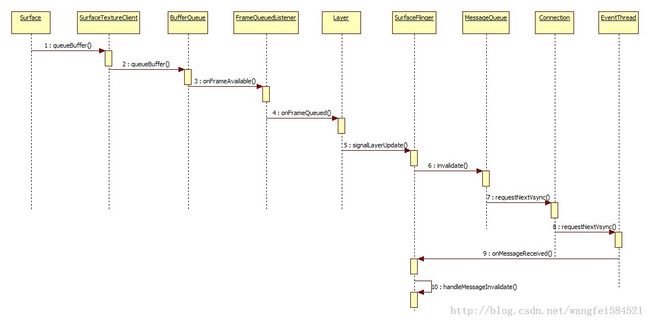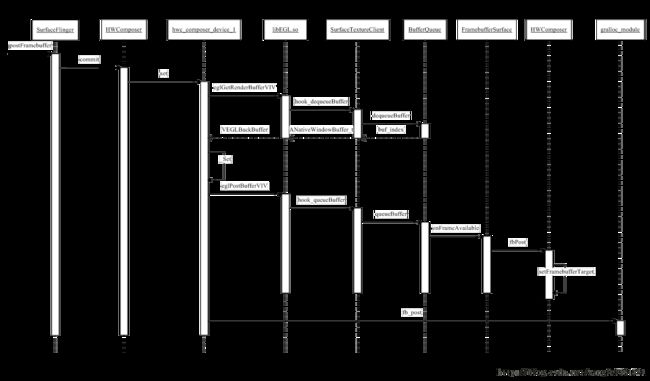详解Android SurfaceFinger服务
概述
SurfaceFlinger是android平台的显示服务,为移动互联网时代的内容呈现和交互提供了平台级的基础。本文以Android4.2的源代码和架构为例,详细介绍SurfaceFlinger服务。
相关类图
启动
SurfaceFlinger服务的源代码位于frameworks/native/cmds/surfaceflinger下:
int main(int argc, char** argv) {
SurfaceFlinger::publishAndJoinThreadPool(true);
// When SF is launched in its own process, limit the number of
// binder threads to 4.
ProcessState::self()->setThreadPoolMaxThreadCount(4);
return 0;
}
为android平台上最常见的native BinderService启动方式。
下边结合binder上层接口粗略分析该段程序。
将"SurfaceFlinger::publishAndJoinThreadPool(true);"
扩展开变为:
sp<IServiceManager> sm(defaultServiceManager());
sm->addService(String16(SERVICE::getServiceName()), new SERVICE(), allowIsolated); // 向servicemanager注册SurfaceFinger服务,以“SurfaceFlinger”作为名字/标识
ProcessState::self()->startThreadPool();
IPCThreadState::self()->joinThreadPool();
ProcessState为每进程的记录binder进程状态的类。主要职责在于:
- 打开binder设备并将binder事务内存映射到本进程地址空间的最开始,尺寸为BINDER_VM_SIZE
- 记录contextobject(一般为servicemanager代理对象)
- 孵化线程/管理线程池
- IBinder和handle之间的转换和查询
ProcessState::self()->startThreadPool();
通过创建一个额外线程(自动进入looper状态)来启动线程池,
IPCThreadState::self()->joinThreadPool();
IPCThreadState为每线程(通过编程本地存储实现)的管理binder thread状态的类,同时负责与binder设备之间的数据交换,其成员:
Parcel mIn;
Parcel mOut;
承担着binder的flat/unflat、发出请求到binder、从binder设备接收client端的请求等任务。
这样子主线程也进入looper模式,现在进入joinThreadPool方法:
binder通信的主要细节就在此方法中,主要思想便是通过talkWithDriver来取到本进程接收到的binder请求并将其反序列化为mIn身上,读出cmd并执行之,摘取几个重要的cmd如下:
BR_TRANSACTION:代表一次binder事务,最常见的便是RPC调用了
binder_transaction_data tr;
......
if (tr.target.ptr) {
sp<BBinder> b((BBinder*)tr.cookie);
const status_t error = b->transact(tr.code, buffer, &reply, tr.flags);
if (error < NO_ERROR) reply.setError(error);
} else {
const status_t error = the_context_object->transact(tr.code, buffer, &reply, tr.flags);
if (error < NO_ERROR) reply.setError(error);
}
binder_transaction_data身上带有服务端的BBinder(client端第一次从servicemanager查询到服务端时被告知并由binder driver记录),
当tr.target.ptr非空时,通过该BBinder对象的transact函数来完成RPC。否则意味着对context_object(通常为本进程内的BpServiceManager对象,且对应handle为0 )的请求。
BBinder的子类通过onTransact函数来服务各种RPC调用。在本文中,便是SurfaceFlinger对象的onTransact函数来应对client的请求。
BR_SPAWN_LOOPER:
前边启动过程中,binder thread包括主线程(SurfaceFlinger对象构造过程中也创建了额外辅助进程,但不是binder thread,排除在外,在本文后半部分分析)一共是两个。当有多个client请求时,势必binder thread不够用(binder driver簿记binder thread的各种信息),此时binder driver便post BR_SPAWN_LOOPER类型的cmd,让本进程预先孵化下一个binder thread,且此后孵化的线程不会进入looper模式(主要处理线程),只是登记为looper(目前在driver中未看出来两者明显区别)
另外,当本进程需要其他服务的协助的时候呢,本进程也需要作为client来发起binder请求,此时便用到了BpBinder::transact()函数,BpBinder成员mHandle用来引用远端对象,作为参数传递给IPCThreadState::self()->transact()来完成。其原理与前述接受binder请求的过程相反,不再赘述。
SurfaceFlinger构造
此步骤是前述启动步骤中的一小步,但也是展现出特定service与众不同的最大一步。
如文件第一部分所列类图所示,SurfaceFlinger继承自多个基类:
class SurfaceFlinger : public BinderService<SurfaceFlinger>,
public BnSurfaceComposer,
private IBinder::DeathRecipient,
private Thread,
private HWComposer::EventHandler
构造函数非常轻量级,只获取了几个系统debug设置。
在ServiceManager addservice时第一次引用刚创建的SurfaceFinger对象,其基类RefBase的onFirstRef被调用:
void SurfaceFlinger::onFirstRef()
{
mEventQueue.init(this);
run("SurfaceFlinger", PRIORITY_URGENT_DISPLAY);
// Wait for the main thread to be done with its initialization
mReadyToRunBarrier.wait();
}
初始化EventQueue,并建立Looper/Handler这对好基友。
接下来启动自己(SurfaceFlinger也是Thread对象),
然后主线程阻塞住直到ReadyToRun(Thread真正启动前的一次性初始化函数)被调用。
接下来咱们转到ReadyToRun函数,鉴于该函数如一枚知性的熟女——深有内涵:
ALOGI( "SurfaceFlinger's main thread ready to run. "
"Initializing graphics H/W...");
// initialize EGL for the default display
mEGLDisplay = eglGetDisplay(EGL_DEFAULT_DISPLAY);
eglInitialize(mEGLDisplay, NULL, NULL);
// Initialize the H/W composer object. There may or may not be an
// actual hardware composer underneath.
mHwc = new HWComposer(this,
*static_cast<HWComposer::EventHandler *>(this));
// initialize the config and context
EGLint format = mHwc->getVisualID();
mEGLConfig = selectEGLConfig(mEGLDisplay, format);
mEGLContext = createGLContext(mEGLDisplay, mEGLConfig);
LOG_ALWAYS_FATAL_IF(mEGLContext == EGL_NO_CONTEXT,
"couldn't create EGLContext");
// initialize our non-virtual displays
for (size_t i=0 ; i<DisplayDevice::NUM_DISPLAY_TYPES ; i++) {
DisplayDevice::DisplayType type((DisplayDevice::DisplayType)i);
mDefaultDisplays[i] = new BBinder();
wp<IBinder> token = mDefaultDisplays[i];
// set-up the displays that are already connected
if (mHwc->isConnected(i) || type==DisplayDevice::DISPLAY_PRIMARY) {
// All non-virtual displays are currently considered secure.
bool isSecure = true;
mCurrentState.displays.add(token, DisplayDeviceState(type));
sp<FramebufferSurface> fbs = new FramebufferSurface(*mHwc, i);
sp<SurfaceTextureClient> stc = new SurfaceTextureClient(
static_cast< sp<ISurfaceTexture> >(fbs->getBufferQueue()));
sp<DisplayDevice> hw = new DisplayDevice(this,
type, isSecure, token, stc, fbs, mEGLConfig);
if (i > DisplayDevice::DISPLAY_PRIMARY) {
// FIXME: currently we don't get blank/unblank requests
// for displays other than the main display, so we always
// assume a connected display is unblanked.
ALOGD("marking display %d as acquired/unblanked", i);
hw->acquireScreen();
}
mDisplays.add(token, hw);
}
}
// we need a GL context current in a few places, when initializing
// OpenGL ES (see below), or creating a layer,
// or when a texture is (asynchronously) destroyed, and for that
// we need a valid surface, so it's convenient to use the main display
// for that.
sp<const DisplayDevice> hw(getDefaultDisplayDevice());
// initialize OpenGL ES
DisplayDevice::makeCurrent(mEGLDisplay, hw, mEGLContext);
initializeGL(mEGLDisplay);
// start the EventThread
mEventThread = new EventThread(this);
mEventQueue.setEventThread(mEventThread);
// initialize our drawing state
mDrawingState = mCurrentState;
// We're now ready to accept clients...
mReadyToRunBarrier.open();
// set initial conditions (e.g. unblank default device)
initializeDisplays();
// start boot animation
startBootAnim();
return NO_ERROR;
我们将其曼妙身段划分为如下:
- EGL初始化
- Hardware Composer初始化
- 选择EGLConfig并创建EGLContext
- 初始化各个DisplayDevice
- 初始化OpenGL ES并绑定到当前进程,初始化EGLDisplay
- 创建EventThread用于为mEventQueue身上的Handler/Looper搞基提供上下文
- 通知主线程,让其继续运行
- 初始化显示,并显示启动动画(通过“property_set("ctl.start", "bootanim")”)
下边摘取其中一些关键步骤分析:
EGL初始化
EGL初始化主要通过eglGetDisplay()来实现,其参数为EGL_DEFAULT_DISPLAY(一个handle值,意义依赖于具体平台):
EGLDisplay eglGetDisplay(EGLNativeDisplayType display)
{
clearError();
uint32_t index = uint32_t(display);
if (index >= NUM_DISPLAYS) {
return setError(EGL_BAD_PARAMETER, EGL_NO_DISPLAY);
}
if (egl_init_drivers() == EGL_FALSE) {
return setError(EGL_BAD_PARAMETER, EGL_NO_DISPLAY);
}
EGLDisplay dpy = egl_display_t::getFromNativeDisplay(display);
return dpy;
}
接下来的调用栈为:egl_init_drivers->egl_init_drivers_locked,egl_init_drivers_locked中主要就是根据/system/lib/egl/egl.cfg文件中配置信息(其中便指定了{tag}的值)运行时装载libGLESv1_CM_{tag}.so,libGLESv2_{tag}.so libEGL_{tag}.so,并将egl_entries.in中的egl函数簇的地址全部找到并绑定到egl_connection_t的egl成员上,将entries.in中的gl函数簇的地址全部找到并绑定到egl_connection_t的hooks上,所以最终的egl的一堆东西都保存在了进程全局变量:
egl_connection_t gEGLImpl; gl_hooks_t gHooks[2];
上(gEGLImpl成员含有对gHooks的指针)。
接下来便是拿到EGLDisplay的过程,包含在egl_display_t::getFromNativeDisplay(display)中,其实现是调用上一步中装载的EGL库中的"eglGetDisplay"函数来获得真正实现并设定给egl_display_t::sDisplay[NUM_DISPLAYS].dpy,返回egl_display_t::sDisplay数组中第一个invalid项的索引作为EGLDisplay handle
接下来便是EGL初始化的过程:
EGLBoolean eglInitialize(EGLDisplay dpy, EGLint *major, EGLint *minor)
{
clearError();
egl_display_ptr dp = get_display(dpy);
if (!dp) return setError(EGL_BAD_DISPLAY, EGL_FALSE);
EGLBoolean res = dp->initialize(major, minor);
return res;
}
其中关键步骤体现在dp->initialize中,展开它的实现:
EGLBoolean egl_display_t::initialize(EGLint *major, EGLint *minor) {
Mutex::Autolock _l(lock);
if (refs > 0) {
if (major != NULL)
*major = VERSION_MAJOR;
if (minor != NULL)
*minor = VERSION_MINOR;
refs++;
return EGL_TRUE;
}
#if EGL_TRACE
// Called both at early_init time and at this time. (Early_init is pre-zygote, so
// the information from that call may be stale.)
initEglTraceLevel();
initEglDebugLevel();
#endif
setGLHooksThreadSpecific(&gHooksNoContext); // 将前边从egl库中取出来的glhooks绑定到thread的TLS上,Note:bionic c为OpenGL预留了专用的TLS,see:bionic_tls.h
// initialize each EGL and
// build our own extension string first, based on the extension we know
// and the extension supported by our client implementation
egl_connection_t* const cnx = &gEGLImpl;
cnx->major = -1;
cnx->minor = -1;
if (cnx->dso) {
#if defined(ADRENO130)
#warning "Adreno-130 eglInitialize() workaround"
/*
* The ADRENO 130 driver returns a different EGLDisplay each time
* eglGetDisplay() is called, but also makes the EGLDisplay invalid
* after eglTerminate() has been called, so that eglInitialize()
* cannot be called again. Therefore, we need to make sure to call
* eglGetDisplay() before calling eglInitialize();
*/
if (i == IMPL_HARDWARE) {
disp[i].dpy = cnx->egl.eglGetDisplay(EGL_DEFAULT_DISPLAY);
}
#endif
EGLDisplay idpy = disp.dpy;
if (cnx->egl.eglInitialize(idpy, &cnx->major, &cnx->minor)) { // 调用egl库中的eglInitialize
//ALOGD("initialized dpy=%p, ver=%d.%d, cnx=%p",
// idpy, cnx->major, cnx->minor, cnx);
// display is now initialized
disp.state = egl_display_t::INITIALIZED;
// get the query-strings for this display for each implementation
disp.queryString.vendor = cnx->egl.eglQueryString(idpy, // 查询一些meta信息
EGL_VENDOR);
disp.queryString.version = cnx->egl.eglQueryString(idpy,
EGL_VERSION);
disp.queryString.extensions = cnx->egl.eglQueryString(idpy,
EGL_EXTENSIONS);
disp.queryString.clientApi = cnx->egl.eglQueryString(idpy,
EGL_CLIENT_APIS);
} else {
ALOGW("eglInitialize(%p) failed (%s)", idpy,
egl_tls_t::egl_strerror(cnx->egl.eglGetError()));
}
}
// the query strings are per-display
mVendorString.setTo(sVendorString);
mVersionString.setTo(sVersionString);
mClientApiString.setTo(sClientApiString);
// we only add extensions that exist in the implementation
char const* start = sExtensionString; // 装配扩展信息
char const* end;
do {
// find the space separating this extension for the next one
end = strchr(start, ' ');
if (end) {
// length of the extension string
const size_t len = end - start;
if (len) {
// NOTE: we could avoid the copy if we had strnstr.
const String8 ext(start, len);
// now look for this extension
if (disp.queryString.extensions) {
// if we find it, add this extension string to our list
// (and don't forget the space)
const char* match = strstr(disp.queryString.extensions, ext.string());
if (match && (match[len] == ' ' || match[len] == 0)) {
mExtensionString.append(start, len+1);
}
}
}
// process the next extension string, and skip the space.
start = end + 1;
}
} while (end);
egl_cache_t::get()->initialize(this); // 初始化egl_cache
char value[PROPERTY_VALUE_MAX];
property_get("debug.egl.finish", value, "0");
if (atoi(value)) {
finishOnSwap = true;
}
property_get("debug.egl.traceGpuCompletion", value, "0");
if (atoi(value)) {
traceGpuCompletion = true;
}
refs++;
if (major != NULL)
*major = VERSION_MAJOR;
if (minor != NULL)
*minor = VERSION_MINOR;
mHibernation.setDisplayValid(true); // Hibernation相关
return EGL_TRUE;
}
Hardware Composer初始化
Hardware Composer的构造函数如下:
HWComposer::HWComposer(
const sp<SurfaceFlinger>& flinger,
EventHandler& handler)
: mFlinger(flinger),
mFbDev(0), mHwc(0), mNumDisplays(1),
mCBContext(new cb_context),
mEventHandler(handler),
mVSyncCount(0), mDebugForceFakeVSync(false)
{
for (size_t i =0 ; i<MAX_DISPLAYS ; i++) {
mLists[i] = 0;
}
char value[PROPERTY_VALUE_MAX];
property_get("debug.sf.no_hw_vsync", value, "0");
mDebugForceFakeVSync = atoi(value);
bool needVSyncThread = true;
// Note: some devices may insist that the FB HAL be opened before HWC.
loadFbHalModule(); // load gralloc HAL模块
loadHwcModule(); // load hwcomposer HAL模块
if (mFbDev && mHwc && hwcHasApiVersion(mHwc, HWC_DEVICE_API_VERSION_1_1)) {
// close FB HAL if we don't needed it.
// FIXME: this is temporary until we're not forced to open FB HAL
// before HWC.
framebuffer_close(mFbDev);
mFbDev = NULL;
}
// If we have no HWC, or a pre-1.1 HWC, an FB dev is mandatory.
if ((!mHwc || !hwcHasApiVersion(mHwc, HWC_DEVICE_API_VERSION_1_1))
&& !mFbDev) {
ALOGE("ERROR: failed to open framebuffer, aborting");
abort();
}
// these display IDs are always reserved
for (size_t i=0 ; i<HWC_NUM_DISPLAY_TYPES ; i++) {
mAllocatedDisplayIDs.markBit(i);
}
if (mHwc) {
ALOGI("Using %s version %u.%u", HWC_HARDWARE_COMPOSER,
(hwcApiVersion(mHwc) >> 24) & 0xff,
(hwcApiVersion(mHwc) >> 16) & 0xff);
if (mHwc->registerProcs) { // 有hardware composer的情形下,需要注册一些callback函数给它,来接受通知
mCBContext->hwc = this;
mCBContext->procs.invalidate = &hook_invalidate; // invalidate hook
mCBContext->procs.vsync = &hook_vsync; // vsync hook
if (hwcHasApiVersion(mHwc, HWC_DEVICE_API_VERSION_1_1))
mCBContext->procs.hotplug = &hook_hotplug; // hotplug hook
else
mCBContext->procs.hotplug = NULL;
memset(mCBContext->procs.zero, 0, sizeof(mCBContext->procs.zero));
mHwc->registerProcs(mHwc, &mCBContext->procs); // 真正注册
}
// don't need a vsync thread if we have a hardware composer
needVSyncThread = false; // 因为hardware composer存在,VSync由它来trigger,在SurfaceFlinger服务进程无需自己创建Vsync线程
// always turn vsync off when we start
eventControl(HWC_DISPLAY_PRIMARY, HWC_EVENT_VSYNC, 0);
// the number of displays we actually have depends on the
// hw composer version
if (hwcHasApiVersion(mHwc, HWC_DEVICE_API_VERSION_1_2)) {
// 1.2 adds support for virtual displays
mNumDisplays = MAX_DISPLAYS;
} else if (hwcHasApiVersion(mHwc, HWC_DEVICE_API_VERSION_1_1)) {
// 1.1 adds support for multiple displays
mNumDisplays = HWC_NUM_DISPLAY_TYPES;
} else {
mNumDisplays = 1;
}
}
// 从gralloc模块获取一些显示输出相关信息
if (mFbDev) {
ALOG_ASSERT(!(mHwc && hwcHasApiVersion(mHwc, HWC_DEVICE_API_VERSION_1_1)),
"should only have fbdev if no hwc or hwc is 1.0");
DisplayData& disp(mDisplayData[HWC_DISPLAY_PRIMARY]);
disp.connected = true;
disp.width = mFbDev->width;
disp.height = mFbDev->height;
disp.format = mFbDev->format;
disp.xdpi = mFbDev->xdpi;
disp.ydpi = mFbDev->ydpi;
if (disp.refresh == 0) {
disp.refresh = nsecs_t(1e9 / mFbDev->fps);
ALOGW("getting VSYNC period from fb HAL: %lld", disp.refresh);
}
if (disp.refresh == 0) {
disp.refresh = nsecs_t(1e9 / 60.0);
ALOGW("getting VSYNC period from thin air: %lld",
mDisplayData[HWC_DISPLAY_PRIMARY].refresh);
}
} else if (mHwc) {
// here we're guaranteed to have at least HWC 1.1
for (size_t i =0 ; i<HWC_NUM_DISPLAY_TYPES ; i++) {
queryDisplayProperties(i);
}
}
if (needVSyncThread) { // 如果Hardware composer不存在,则需要在SurfaceFlinger进程中创建VSync线程
// we don't have VSYNC support, we need to fake it
mVSyncThread = new VSyncThread(*this);
}
}
SurfaceFlinger实现了HWComposer::EventHandler接口,所以最终的 VSync和Hotplug处理在SurfaceFlinger::onVSyncReceived()和SurfaceFlinger::onHotplugReceived()中。
选择EGLConfig并创建EGLContext
// initialize the config and context
EGLint format = mHwc->getVisualID(); // 从hardware composer取到颜色空间
mEGLConfig = selectEGLConfig(mEGLDisplay, format); // 生成EGLConfig
mEGLContext = createGLContext(mEGLDisplay, mEGLConfig); //生成EGLContext(通过调用egl库的eglCreateContext函数,然后封装成egl_context_t对象)
初始化各个DisplayDevice
// initialize our non-virtual displays
for (size_t i=0 ; i<DisplayDevice::NUM_DISPLAY_TYPES ; i++) {
DisplayDevice::DisplayType type((DisplayDevice::DisplayType)i);
mDefaultDisplays[i] = new BBinder();
wp<IBinder> token = mDefaultDisplays[i];
// set-up the displays that are already connected
if (mHwc->isConnected(i) || type==DisplayDevice::DISPLAY_PRIMARY) {
// All non-virtual displays are currently considered secure.
bool isSecure = true;
mCurrentState.displays.add(token, DisplayDeviceState(type));
sp<FramebufferSurface> fbs = new FramebufferSurface(*mHwc, i);
sp<SurfaceTextureClient> stc = new SurfaceTextureClient(
static_cast< sp<ISurfaceTexture> >(fbs->getBufferQueue()));
sp<DisplayDevice> hw = new DisplayDevice(this,
type, isSecure, token, stc, fbs, mEGLConfig);
if (i > DisplayDevice::DISPLAY_PRIMARY) {
// FIXME: currently we don't get blank/unblank requests
// for displays other than the main display, so we always
// assume a connected display is unblanked.
ALOGD("marking display %d as acquired/unblanked", i);
hw->acquireScreen();
}
mDisplays.add(token, hw);
}
}
DisplayDevice封装了一个显示设备,组合了之前分析过的hardware composer, framebuffer surface, SurfaceTextureClient, EGLConfig.在SurfaceFlinger的合成和显示的每个点上都会遍历这个DisplayDevice集合。
初始化OpenGL ES并绑定到当前进程,初始化EGLDisplay
// initialize OpenGL ES
DisplayDevice::makeCurrent(mEGLDisplay, hw, mEGLContext);
initializeGL(mEGLDisplay);
ReadyToRun终于运行完了,接下来便进入真正的threadloop:
bool SurfaceFlinger::threadLoop() {
waitForEvent(); // 通过Looper等待事件
return true;
}
创建Surface
Android中创建创建一个Activity时创建Surface的流程:
● Activity Thread calls on attach() and makeVisible()
● makeVisible does wm.addView()
● vm.addView() - this also called by StatusBar to display itself
● Creates a new ViewRootImpl
● Call on its setView()
● setView() calls on sWindowSession.add(...)
● This results in call to WM's addWindow()
● ViewRootImpl's performTraversals()
● Calls on relayoutWindow()
● Calls to WM session's relayout()
● Call to WM's relayoutWindow()
● Call to createSurfaceLocked()
● new Surface(...) // Surface Object @java-layer
Surface构造函数调用了一个nativeCreate的native方法,其实现位于frameworks/base/core/jni/android_view_Surface.cpp:
static void nativeCreate(JNIEnv* env, jobject surfaceObj, jobject sessionObj,
jstring nameStr, jint w, jint h, jint format, jint flags) {
ScopedUtfChars name(env, nameStr);
sp<SurfaceComposerClient> client(android_view_SurfaceSession_getClient(env, sessionObj));
sp<SurfaceControl> surface = client->createSurface(
String8(name.c_str()), w, h, format, flags);
if (surface == NULL) {
jniThrowException(env, OutOfResourcesException, NULL);
return;
}
setSurfaceControl(env, surfaceObj, surface);
}
与此类似,接下来粘贴一段Native层创建Surface的Sample代码:
mComposerClient = new SurfaceComposerClient;
ASSERT_EQ(NO_ERROR, mComposerClient->initCheck());
sp<IBinder> display(SurfaceComposerClient::getBuiltInDisplay(
ISurfaceComposer::eDisplayIdMain));
DisplayInfo info;
SurfaceComposerClient::getDisplayInfo(display, &info); // 获取显示参数
ssize_t displayWidth = info.w;
ssize_t displayHeight = info.h;
// Background surface
mBGSurfaceControl = mComposerClient->createSurface( // 创建Surface,后文将详细分析其squence
String8("BG Test Surface"), displayWidth, displayHeight,
PIXEL_FORMAT_RGBA_8888, 0);
ASSERT_TRUE(mBGSurfaceControl != NULL);
ASSERT_TRUE(mBGSurfaceControl->isValid());
fillSurfaceRGBA8(mBGSurfaceControl, 63, 63, 195);
// Fill an RGBA_8888 formatted surface with a single color.
static void fillSurfaceRGBA8(const sp<SurfaceControl>& sc,
uint8_t r, uint8_t g, uint8_t b) {
Surface::SurfaceInfo info;
sp<Surface> s = sc->getSurface();
ASSERT_TRUE(s != NULL);
ASSERT_EQ(NO_ERROR, s->lock(&info));
uint8_t* img = reinterpret_cast<uint8_t*>(info.bits);
for (uint32_t y = 0; y < info.h; y++) {
for (uint32_t x = 0; x < info.w; x++) {
uint8_t* pixel = img + (4 * (y*info.s + x));
pixel[0] = r;
pixel[1] = g;
pixel[2] = b;
pixel[3] = 255;
}
}
ASSERT_EQ(NO_ERROR, s->unlockAndPost());
}
其中CreateSurface过程的时序图如下:
queueBuffer的过程时序图如下:
VSync的时序图:
在dequeue了新的GraphicBuffer之后,SurfaceFlinger就需要对它管理的layer进行合成。合成的过程主要包含了以下几个重要的步骤:
handleMessageTransaction:处理系统显示屏以及应用程序窗口的属性变化。并把SurfaceFlinger::mDrawingStat更新为SurfaceFlinger::mCurrentState,新创建的layer(surface)都是保存在mCurrentState中的。
handlePageFlip:更新每个layer的active buffer。
rebuildLayerStacks:为每个DisplayDevice设置可见、按Z-order排序的layers
setUpHWComposer:根据在step3设置的SurfaceFlinger的DisplayDevice中的active layers来设置HWComposer的DisplayData数据,然后调用hwc模块的prepare函数
doComposition:使用OpenGL ES或者hwc模块来合成
在合成完后,就需要推送到屏幕上显示。有3个重要的类用来管理显示设备:
Android系统支持多个显示设备,每一个显示设备在SurfaceFlinger进程中都有一个DisplayDevice对象来管理它。
FramebufferSurface继承于ConsumerBase,当其连接的BufferQueue有新帧时,其onFrameAvailable方法会被调用,来处理这个新帧。
SurfaceTextureClient继承于ANativeWindow,在SurfaceFlinger进程中,它引用了FramebufferSurface的BufferQueue;同时又因为它是一个ANativeWindow,它被EGL封装为EGLSurface保存在DisplayDevice 中,用来显示改设备的新帧。
DisplayDevice的初始化过程在SurfaceFlinger::readyToRun()里实现。
下面重点介绍两种不同情况下的显示流程:
没有HWC模块时:
有HWC模块时:





